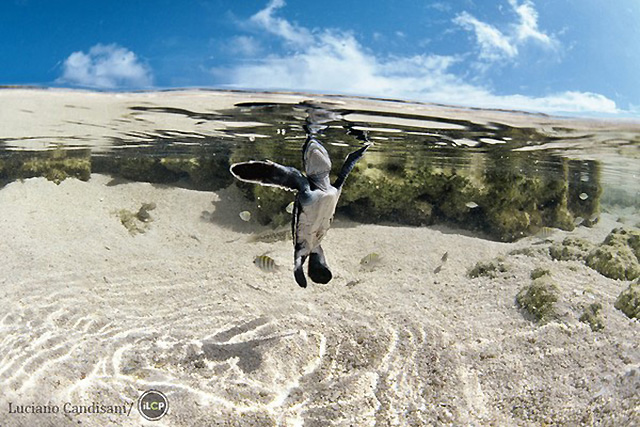Filtered By: Scitech
SciTech
Bohol's marine ecosystem threatened by overfishing
By MACY AÑONUEVO

A young marine turtle is one of many species that thrive in the Danajon Bank in Bohol and one of six double-barrier reefs in the world. The photograph taken by underwater photographer Luciano Candisani, a member of the "Project Seahorse" expedition team organized by the Int'l League of Conservation Photographers (iLCP), is included in a series of images taken from one of the most important marine ecosystems in the entire Pacific Ocean.
Apex predators such as large-bodied sharks and tunas are so scarce in Bohol's Danajon Bank, they don't affect the ecosystem anymore. The fisheries catch has also shifted towards lower trophic level fish and invertebrates. Illegal fishing accounts for almost 25% of the entire municipal fisheries catch, taking away income from fishermen who use legal fishing methods. The sustainability of the entire fishery is now at risk.
The "trophic level" of an organism describes its position within the food web. Primary producers such as plants are Trophic Level 1, and carnivores are at a higher trophic level compared to herbivores. Fishing typically removes top-level predators first. When these predators are fished out, fishermen then shift to target fish at a lower trophic level. This phenomenon is often referred to as "fishing down the food web".
Danajon Bank in danger
Regina Bacalso from Fisheries Improved for Sustainable Harvest (FISH) Project and Matthias Wolfe from the Leibniz Center for Tropical Marine Ecology consolidated data from fish visual censuses, trawl surveys, and fisheries surveys and built an Ecopath model to analyze the effects of both legal and illegal fishing on the ecosystem of Danajon Bank. Danajon Bank is located north of Bohol Island in the central Visayas region. It is 130 kilometers long and is one of only six double barrier reefs in the world. More than 50% of the municipal fishers and fishing boats of the entire province depend on the northwest Bohol section of Danajon Bank.
They found that the mean trophic level (mTL) of the fishery is only 2.95, indicating that the catch is mostly composed of lower trophic level animals like herbivorous fish (i.e. rabbitfish, surgeonfish), small pelagic fish (i.e. anchovies, sardines), and invertebrates (i.e. crabs, shrimps, shellfish). Higher tropic level fish such as sharks, tunas, and groupers were also largely absent from the catches. They're so few in number that mid-level predators like barracuda and jacks haven taken over the position of "apex predator". Ironically, "fishing down the food web" sustained the high volumes of fishery landings because when predators are fished out, their prey, who are the new fishery target, are released from pressure and increase in abundance. But while these result in short-term gains, the removal of top predators affects the overall productivity and stability of the ecosystem. They also found that among the different illegal fishing methods, blast fishing, Danish seines, and spear fishing with compressors had the largest negative impact on the fishery.
As the impacts of overfishing and illegal fishing operations aren't restricted by local government unit jurisdictions and boundaries, the authors highlighted the importance of system-wide management actions. They write,
"The long-term sustainability of the Danajon Bank fisheries is doubtful if present exploitation patterns continue. ... Thus, coordinated system-wide fisheries enforcement aimed at completely removing the illegal and destructive fishing operations could significantly reduce the overall fishing effort and resource extraction, which subsequently could aid in the recovery of the depleted upper TL [trophic level] group populations and biomasses, and furthermore, improve the overall ecosystem structure and resource sustainability."
A global problem
Fishing down the food web is not restricted to the Philippines. Researchers from Plymouth University and non-profit research organization WorldFish compiled over 90 years of English Channel fisheries catch data from the International Council for the Exploration of the Sea (ICES) and found that while fisheries catches increased from 9,146 tons in 1920 to averages of 130,000 to 150,000 in 2000-2010, the mTL of the catch declined from 4.0 to 3.0 over the same time period.
The mTL decreased because the catch shifted from fish (primarily cod, hake, haddock, sharks, and rays) to invertebrates. The "miscellaneous aquatic invertebrates" (mostly scallops and prawns) and "squid, cuttlefish, and octopus" ICES categories have accounted for more than half of the catch since the 1970s. The 75,000 km2 area of the English Channel is an extension of the Atlantic Ocean and separates southern England from northern France. — TJD, GMA News
Macy Añonuevo earned her MS Marine Science degree from the University of the Philippines. She is a published science and travel writer and was a finalist in the 2013 World Responsible Tourism Awards under the Best Photography for Responsible Tourism category. Her writings and photographs may be found at www.theislandergirl.com.
The mTL decreased because the catch shifted from fish (primarily cod, hake, haddock, sharks, and rays) to invertebrates. The "miscellaneous aquatic invertebrates" (mostly scallops and prawns) and "squid, cuttlefish, and octopus" ICES categories have accounted for more than half of the catch since the 1970s. The 75,000 km2 area of the English Channel is an extension of the Atlantic Ocean and separates southern England from northern France. — TJD, GMA News
Macy Añonuevo earned her MS Marine Science degree from the University of the Philippines. She is a published science and travel writer and was a finalist in the 2013 World Responsible Tourism Awards under the Best Photography for Responsible Tourism category. Her writings and photographs may be found at www.theislandergirl.com.
More Videos
Most Popular




